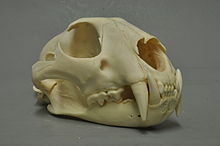Java leopard
| Java leopard | ||||||||||||
|---|---|---|---|---|---|---|---|---|---|---|---|---|

Java leopard ( Panthera pardus melas ) in Tierpark Berlin |
||||||||||||
| Systematics | ||||||||||||
|
||||||||||||
| Scientific name | ||||||||||||
| Panthera pardus melas | ||||||||||||
| ( Cuvier , 1809) |
The Java leopard ( Panthera pardus melas ) is the smallest subspecies of the leopard . Its distribution area is on the Indonesian island of Java . It once extended over the entire island and a few small neighboring islands. The Java leopard is threatened with extinction today, the total population in the wild is probably less than 250 animals, possibly even less than 100.
features

The Java leopard reaches a head-torso length of up to 140 cm and a height of 80 cm. The tail is between 50 and 60 cm long, and its weight is up to 80 kg. Its life expectancy is 20 years. The Java leopard differs from other leopard subspecies by its smaller build, dense, short fur and small, closely spaced, black rosettes. Its coat color varies from ocher yellow to reddish brown. In this subspecies, there are particularly frequent blacks, so-called panthers , this color form is inherited in a recessive manner.
The Java leopard occupies a special position among the leopards, because according to the latest studies it forms the sister line to all other Asian leopards, which also makes it the most primitive representative of all leopard subspecies. This is due to the isolation on Java.
Distribution area and existence
Due to the heavy hunting and the destruction of its habitats, the Java leopard is now very threatened with extinction. The high population density on Java inevitably leads to conflicts with the big cat .
The population density of the leopard in Java's Gunung Gede Pangrango National Park was estimated at one individual per 6 km², in Gunung Halimun-Salak National Park at one individual per 6.5 km².
Confirmed occurrences are known from the following national parks: Ujung Kulon NP, Gunung Gede Pangrango NP, Gunung Halimun-Salak NP, Ciremai NP, Merbabu NP, Merapi NP, Bromo Tengger Semeru NP, Meru Betiri NP, Baluran NP and Alas Purwo NP. If you add up the dimensions of these parks, the area for the animals is only 2,267.9 - 3,277.3 km². If one takes the above mentioned population density as a guideline, there is a potential population density of 363 to 525 leopards that the parks can contain.
The Java leopard is one of the most threatened cat subspecies and is classified by the IUCN as critically endangered ( critically endangered ).
Way of life
Like all leopards, the Java leopard lives solitary and can often be found on trees during the day because it is primarily active at night and at dawn. Its food spectrum consists mainly of meat, monkeys, rodents, reptiles and birds are mainly hunted. Due to the threat to the maned deer ( Rusa timorensis ), the Java leopard loses an important part of its prey. It also drags its prey up trees for consumption.
Keeping in human care
In Europe, the Javan leopard is only in the Tierpark Berlin , the Prague Zoo and Bioparc de Doue-la-Fontaine to see. While there are currently five animals living in the Berlin Zoo, the Prague Zoo and the Bioparc de Doué-la-Fontaine each house a male from the offspring of the Berlin Zoo. On January 16, 2012, a male and a female young animal were born in the Berlin zoo (first breeding).
literature
- David Macdonald: The Great Encyclopedia of Mammals. Ullmann / tandem
- Hans Petzsch: Urania Tierreich, 7 vols., Mammals. Urania, Stuttgart (1992)
- Mammals. 700 species in their habitats. Dorling Kindersley, (2004)
Web links
- Species profile Java leopard; IUCN / SSC Cat Specialist Group in English
- Profile on Arkive
- IUCN Red list
- zootierliste.de - Overview of the keeping of the Java leopard in zoos
Individual evidence
- ↑ Leopard Halter Zootierliste.de, accessed on August 15, 2017
- ^ The capital zoo: Two young Java leopards in the Berlin zoo